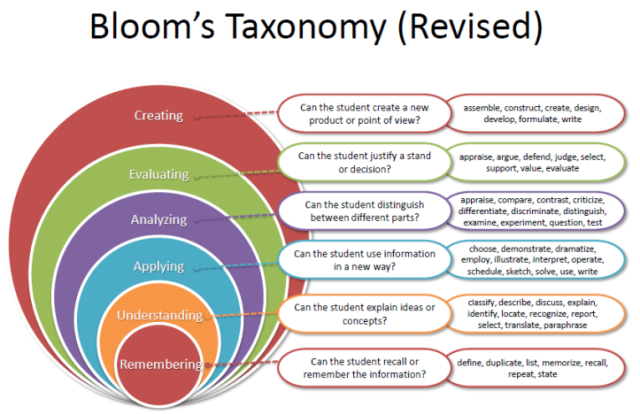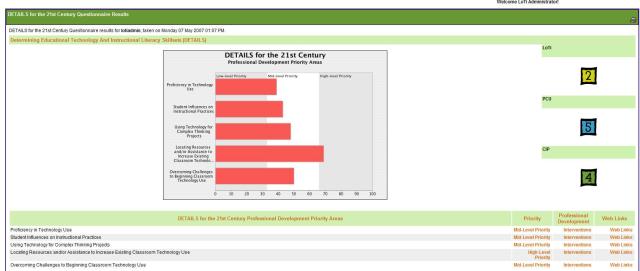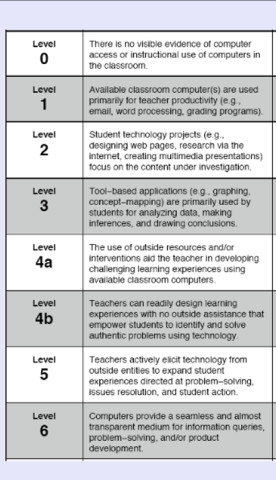Featured Articles
Technology Integration
- Details
- Category: Curriculum and Educational Practices
Background
If I go back over 15 years ago, when I was first starting out in my doctoral studies, I was concerned about how technology fit into education. As a technology coordinator for a school district, I saw more technology being introduced into the district without a clear path of direction as to integrating the technology into the curriculum. Numerous computers were purchased to place in the computer labs and classrooms. However, the key part that was missing in this process was the lack of professional development needed to integrate this new technology. As I completed my doctoral studies and began to focus on my dissertation, I wanted to look at a way to prepare teachers better. In planning any professional development, I needed to remember Bloom's Taxonomy. Too often, technology was used in lower levels of Bloom's.
 Bloom's Taxonomy
Bloom's Taxonomy
At that time, I needed a way to measure where teachers were with integrating technology into their classrooms. Fortunately, I heard about LoTi (Levels of Technology Innovation) from my advisor. LoTi survey was a self-assessment tool that allowed teachers to measure several factors: 1) Proficiency in Technology Use; 2) Student Influences on Instructional Practices; 3) Using Technology for Complex Thinking Skills; 4) Locating Resources and/or Assistance to Increase Existing Classroom Technology; and, 4) Overcoming Challenges to Beginning Classroom Technology Use. The other aspect of the survey was the results in three categories (noted in the picture below). The first score is the LoTi (Level of Technology Implementation), the PCU (Personal Computer Use), and CIP (Current Instructional Practice). As I began to put the pieces together on what the focus of my dissertation was going to be I realized if I was going to focus on technology integration, I needed a tool to measure it. However, integration was deeper than having teachers or students use computers. Technology integration had to be project-based and student-centered with an understanding of multiple intelligences. So, in the middle of my doctoral work and being the technology coordinator, I went off to train to become a LoTi-certified mentor.
 LoTi Results
LoTi Results
Upon completing my certification, I meet with administrators to explain to them how the LoTi survey could be a useful tool to help plan any professional development in the future. I asked them to imagine using the results to plan in-service days better. So, if the results showed a teacher that was more student-centered in their approach but lacked technology knowledge, a professional development plan could focus on the technology aspects of teaching. On the other hand, if a teacher were tech-savvy but took more of a teacher-centered approach, their professional development would be to work with them on developing a more student-centered approach. What of the teachers tended to give worksheets to the students? Professional development could focus on project-based learning. The goal would be to get teachers at a LoTi level (see below) of 3 or above.
 LoTi Levels
LoTi Levels
The experience up this time, when it came to professional development, was to take all of the teachers and put them in a computer lab, throw a bunch of software at them, and have them walk away at the end of the day knowing how to use it. For the more advanced users, they would get bored or impatient and start to tune out. You would see them checking their email or surfing the web. Those less experienced teachers would become overwhelmed and feel guilty about holding everyone back from moving forward. Needless to say, this often resulted in teachers scrambling around to each other asking, "How do you do ....?" or "Where do I find ...." Meanwhile, back at my meeting with administrators, I emphasized not to go through with the survey if we wouldn't use it to plan professional development better. Unfortunately, that advice was ignored. Teachers took the survey, the information was gathered, and then a report was given to the Board of Education on the results. After that, the district continued to provide professional development just as it had in the past.
Planning and Implementation
If your school district is looking for a better way to integrate technology into the classroom, knowing what to do and how to get started is imperative. If you are going to make a commitment, you must devise a plan. The level of commitment must go beyond what "looks good." Whether you choose to use the LoTi Survey or another tool, an assessment of where your teachers are regarding technology integration is necessary. Also, you must be committed to providing professional development to teachers. As noted above, this does not mean the one-day in-service session. A long-term plan must be implemented. A note of caution if you decide to use the LoTi Survey - encourage teachers to be honest in their self-assessment. Remind teachers this survey is about where they are now, not where they want to be. Be Honest!
Once the teachers have taken the survey, it's time to assess the results and start planning for the future. As you begin to plan your professional development, you will now have a tool to assist you. Need assistance with this process? That is where Technology in Education Online comes into the picture. My doctoral dissertation was based on technology integration, Using Moodle to Leverage Technology Integration.
What Technology in Education Online can do:
- Coordinate and Implement the LoTi Survey within your district.
- Assist the district in analyzing the data and planning professional development for teachers.
- Meeting with district teachers to go over survey results.
- Provide consultation services.
- Conduct on-site workshops based on the results of the LoTi survey.
- Provide in-class collaboration.
- Face-to-face meetings with teachers to help integrate technology into their classrooms.
If these ideas get you excited and your district wants to move forward, please contact Technology in Education Online. Want to get a sense of my experience, please take a look at the abstract of my dissertation - Abstract - EPP.
Curriculum Practices: What is the Agenda Underlying Conservative Theory?
- Details
- Category: Curriculum and Educational Practices
“School cannot be a place of pleasure, with all the freedom that would imply. School is a factory, and we need to know which workers are up to snuff. . . .The teachers in charge are the floor bosses, so don’t expect them to praise the virtues of free intellectual development when everything, absolutely everything in the school setting—the classes, grades, exams, scales, levels, orientations, streams—enforces the competitive nature of the institution, itself a model of the workaday world (p. 92).” (Pennac 1994)
In defining Curriculum, I suppose we can spend a great deal of time defining what it is and get nowhere to solve today’s public education problems. As we look at who defines it and what’s important, we must ask the questions: What is their agenda? Philosophically, where do they stand regarding the role of education and its institutions?
Traditionalists would have us believe the rules of grammar, reading, rhetoric, logic, mathematics, and the most significant books of the Western World are the tools of the trade. Hutchins stated, “Knowledge is truth. The truth is always the same. Hence education should be everywhere the same” p. 66 (Hutchins 1936). The question I have is whose truth? What is true to me in the little comfort zone of my life in suburban America is not the same for someone raised in the inner city. So should my educational process, or my child’s education, be the same as an inner-city child? Often, there are cries for equal treatment for all! Yet, can this occur when we aren’t all playing on the same level playing field?
Essentialists, according to Arthur Bestor in The Restoration of Learning (1956), focused on five areas of study – 1)command of language; 2)mathematics; 3) science; 4) history; 5) foreign language (p. 48-49) (Bestor 1956). If the sole basis of education is on these five areas, then the question arises: where does the pupils’ interest come into consideration? In the work, What Do 17-Year-Olds Know?, Ravitch and Finn focused on what students didn’t know, as revealed by their wrong answers to multiple-choice test items primarily based on recall of factual information (Ravitch 1987). The question again must be asked: are these results an indication of a failed curriculum, and according to whom? Perennialists and essentialists regard the mind as a vessel to be filled or a muscle to be exercised. Where is the human factor in all of this? It all sounds so mechanical and dry. Is it a wonder students get turned off by our schools? I believe Dewey was correct: “We get the case of the child vs. the curriculum.” (Dewey 1902)
In taking the more conservative approach of accountability and performance contracting, again, we look at factors such as input/output, rational testing, Goals 2000, system analysis, and accountability according to industrial standards and apply them to education. Is this the correct approach? I don’t believe life is so cut and dry. We don’t live in a vacuum. The events of today can adversely affect students. Are we to ask the students in the inner-city areas to ignore events surrounding them, continue memorizing and regurgitating material, and not concern themselves with those non-essential aspects of education? And besides this, do we even want to follow the model of the military-industrial complex? To dispel this concept, we need only look at cost overruns and the lateness in delivering finished goods.
Read more: Curriculum Practices: What is the Agenda Underlying Conservative Theory?
Issues of Identity in Current Teaching Practices
- Details
- Category: Curriculum and Educational Practices
"Fullest self-transcendence is fullest self-regulation, self-expression, and self-actualization. The needs for identity, self-actualization, and self-transcendence are linked with one another, involving the processes of self-love and love for fellow-man and cosmos."[1] "The growing or maturing person finds meaning in life, accepts responsibility, and loses himself in his commitment, disregarding his egoistic impulses of tension reduction, pleasure, and pride. He extends step by step the boundaries of the self, ultimately identifying himself with the highest values that can be comprehended."[2]
When we look at identity as an important aspect of the makeup of the teacher and how they teach, is this identity based on some types of principles? And if so, the first question that arises is whose principles? Who determines what these principles are? Are they some esoteric ideals that simply fall from the sky? Are they determined by some type of policy set by a higher authority? And what determines what a principle is and what isn’t? A principle is defined as “ethical standard: a standard of moral or ethical decision-making.” But again we can go into this continuing pattern of asking the next question that comes out of this definition, who determines what is moral or ethical? It is difficult to get beyond these questions and move on considering how in our societies today, so much of our guidelines for moral and ethical behavior are based on these sound bites given by self-righteous politicians and religious leaders. All fluff and no substance behind their statements.
In looking at how teachers must make a shift in their teaching approach from what they learned in the 1970s and early 1980s. We must shift our focus to a more individualized approach. However, given limited resources, limited time barriers, etc, how do we move from seeing all as one to seeing the individual? There needs to be a shift in teaching methods from the teacher “technician” to what would be defined as a “true” teaching process. How do we motivate and create this change? In a study done by Johnson (1986), it was found that:
Johnson (1986) distinguished three problems that require different orientations to teacher goals: attracting people into the profession, retaining them once there, and engaging them in improving their own performance. Most relevant to our study, the third goal requires the orchestration of organizational incentives that encourage teachers to think about their work in new ways and commit themselves to new standards and goals. According to Johnson’s (1986) review, these incentives should “coordinate teachers’ efforts, provide them with shared purpose, enhance the conditions of their work, and reaffirm their professional identity.”[3]
Page 1 of 2
